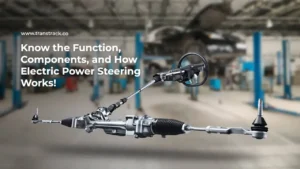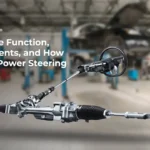How to Get Rid of Rust on Car and Prevention Tips
Posted on July 26, 2024 by Nur Wachda Mihmidati

Rust on cars is not only an aesthetic problem, but it can also damage the structure of the vehicle and reduce its resale value. Rust occurs when the metal on a car is exposed to environmental elements such as water, salt, and moisture without adequate protection. While the process can start from small spots, if left unchecked, rust can spread and cause significant damage.
In this TransTRACK article, we will discuss effective steps to remove rust on cars, from initial preparation to final treatment. By understanding this process and applying the right solutions, you can repair the affected areas and prevent rust from returning. In addition, we will also introduce you to advanced technologies that can help maintain your car’s condition more efficiently.
What causes rust on cars?
All the factors you mentioned can cause rust in cars. Here is the explanation:
Exposure to Rainwater and Moisture
Acidic rainwater and moisture can accelerate the corrosion process if left on the car’s surface without cleaning.
Winter Road Salt
The salt used to treat road snow can accelerate rust because salt promotes metal corrosion, especially if the car is not cleaned regularly.
Damage to the Car’s Paint Coating
A chipped or damaged paint layer provides direct access to the metal of the car body, facilitating the corrosion process.
Lack of Maintenance and Anti-rust Coating
Without sufficient maintenance or anti-rust coating, the car will be more susceptible to rust as there is no added protection to withstand adverse environmental factors.
It is important to regularly clean the car, especially the underside and vulnerable areas, and use anti-rust coatings to protect against damage.
What are the signs that the car is starting to rust?
Signs that your car is starting to rust include:
Red or Brown Spots on the Car Body
This is the first sign of rust starting to appear on the surface of the car. This spotting usually starts from an area of impact or damage to the paint.
Rough and Spotted Surfaces on the Undercarriage of the Car
If you notice a rough, mottled surface on the underside of your car or in areas that are frequently exposed to water and salt, this could be an indication of developing rust.
Metal Parts that Start to Brittle and Break Easily
As rust develops, the metal will become brittle and may start to break or crumble when stressed or impacted.
It is important to inspect the car periodically to detect signs of rust and deal with the problem immediately to prevent further damage.
How to remove rust from a car?
To remove rust from your car, you can follow these steps:
Prepare Tools and Materials
- Wire brush or sandpaper
- Rust remover
- Anti-rust primer
- Appropriate car paint
- Clean and protective cloth such as masking tape
Wash and Dry the Area Affected by Rust
Clean the rust-affected area with soap and water to remove dirt. Dry completely before proceeding.
Remove Rust
- Use a wire brush or sandpaper to remove any rust. Make sure to remove all the rust down to the healthy metal.
- For hard-to-reach areas, you can use a chemical rust remover. Follow the instructions on the product being used.
Smooth and Clean the Area
After removing the rust, level the area with fine sandpaper. Remove dust and rust residue with a clean cloth.
Apply Anti-rust Primer
Apply anti-rust primer to the cleaned area to protect the metal from further rusting. Allow the primer to dry as directed on the package.
Paint and Finishing
- Once the primer is dry, apply paint that matches the color of your car. Apply multiple coats if needed to achieve an even finish and protect the area from future rust.
- Once the paint is dry, consider using additional protective coatings if needed.
Check and Maintain Periodically
- Check the repaired areas regularly and perform regular maintenance to prevent rust from reappearing.
If the rust has spread widely or damaged important structures, you should take the car to a professional repair shop for repairs.
How to prevent rust on cars?
To prevent rust on your car, here are some steps you can take:
Routinely Wash and Dry the Car
Wash your car regularly to remove dirt, salt, and chemicals that can accelerate corrosion. Also make sure to dry the car well, especially in areas that are often exposed to water such as the underside and between the wheels.
Using Undercoating
Apply undercoating to protect the underside of the car from rust. This can be an anti-rust coating that prevents salt, water, and dirt from sticking directly to the metal.
Apply Wax and Sealant
Use wax or sealant to coat the car’s paint. These products provide an additional layer of protection against environmental elements, such as rain and snow, which can accelerate corrosion.
Check and Repair Chipped or Cracked Paint
Regularly inspect the car’s paint and repair any chipped or cracked areas immediately. Damaged paint provides direct access to metal and increases the risk of rust.
By taking these preventive measures, you can extend the life of your car and keep it looking good.
Removing rust from your car requires regular attention and maintenance. By following the steps mentioned, you can keep your vehicle in top condition and avoid more serious damage. However, prevention is the key to avoiding rust problems in the future.
To ensure your car is always in the best condition and prevent rust early on, consider using TransTRACK’s Vehicle Maintenance System. With this system, you can:
- Schedule Periodic Maintenance: Ensure your car gets proper and regular maintenance.
- Monitoring Vehicle Condition: Spot early signs of trouble before they develop into serious damage.
- Get Automatic Alerts: For preventive measures that can prevent further damage.
Keep your car protected and in optimal condition with TransTRACK’s Vehicle Maintenance System. Visit our site or contact us for more information on how we can help you maintain your vehicle more efficiently and effectively.
Recent Post
Know the Function, Components, and How Electric Power Steering Works!
December 24, 2025Know the Types of Buses Based on Their Model, Size, and Capacity!
December 22, 2025Topic :
Recommended Articles

 Bahasa Indonesia
Bahasa Indonesia








